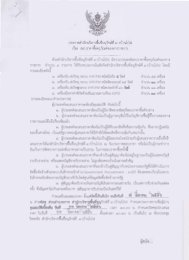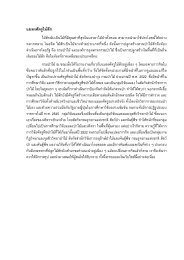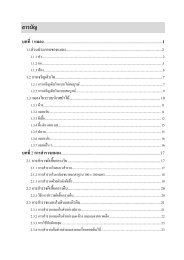Create successful ePaper yourself
Turn your PDF publications into a flip-book with our unique Google optimized e-Paper software.
National Park Office<br />
National Park, Wildlife and Plant Conservation Department<br />
Travel in National Parks<br />
In Touch with Nature Conservation<br />
National Park Bulletin<br />
Blooming Season<br />
<strong>Oct</strong>ober-<strong>Nov</strong>ember<br />
<strong>2004</strong><br />
www.dnp.go.th
2<br />
Contents<br />
Hot News 2<br />
Wild Flowers in Bloom 3<br />
Insect-Eating Plants :<br />
Wonders of Nature 4<br />
Tourist Calendar 5<br />
Butterfly fish are coral fish of beautiful<br />
colours. At least 40 species of butterfly fish have<br />
been identified in Thailand. The most recently<br />
discovered, for the first time in Thailand, is the<br />
dotted butterfly fish, Chactodon semion. It was<br />
found in the vicinity of Ao Phak Kat in Mu Ko<br />
Surin National Park (NP) by Mr. Baramee<br />
Temboongiat.<br />
Hot News<br />
Re-opening of National Parks<br />
Several national parks<br />
have re-opened following<br />
the scheduled closures<br />
for park recuperation and<br />
visitorsû safety during the<br />
monsoon season.<br />
❁ From <strong>Oct</strong>ober 1 st ,<br />
<strong>2004</strong> (2547), the following<br />
parks have re-opened: Phu<br />
Kradueng NP; the nature<br />
trails in Huai Nam Dang NP;<br />
rafting trips on the Mae<br />
Taeng River, the nature study<br />
trails at Doi Chang, Ao Pakarang, Ao Chek and the Ko Kudi Ranger Station in<br />
Khao Laem Ya-Mu Ko Samet NP.<br />
❁ From <strong>Nov</strong>ember 16 th , <strong>2004</strong> (2547), Mu Ko Surin NP, Mu Ko Similan NP,<br />
Mu Ko Lanta NP (around Ko Rok, Kong Hin Daeng and Kong Hin Muang) and<br />
Tarutao NP around Mu Ko Adang-Rawi have also opened to visitors.<br />
Information for Readers<br />
The National Park, Wildlife and Plant Conservation Department (DNP), which publishes this<br />
newsletter, was formed on <strong>Oct</strong>ober 2 nd , 2002 following the reform of government administration.<br />
The DNP is charged with the mission to conserve, protect and rehabilitate the resources,<br />
wildlife and plants of the forest. Its mission also includes the protection and control of existing<br />
protected areas (including national parks) and the rehabilitation of degraded forests to bring<br />
them back to their former condition. The outcome of these activities will be the retention of<br />
balance in the ecosystem and environment as well as the enhancement of biodiversity.<br />
In its capacity as the manager of nature tourism in Thai national parks, the DNP stresses the<br />
importance of a tidy and pollution-free environment. On the auspicious occasion of the 6 th cycle<br />
birthday celebration of the Queen (72 nd birthday in August,<strong>2004</strong>) the DNP initiated a project called<br />
çGreen National Parks, Clear Water and White Sandé, comprising activities such as essay writings<br />
and slogan competitions, a project sending trash back to litter bags, and the promotion of 5 good<br />
practices among park staff (clearing up, convenience, cleanliness, healthy environment and good<br />
habits). Even people with no opportunity to participate in these activities can contribute greatly to<br />
the programme by not bringing foam containers with them when they visit national parks.<br />
Vinich Rukchart<br />
Acting Director, National Park Office<br />
Invitation to View The Best<br />
of Thai National Parks<br />
The public is invited<br />
to read about and enjoy<br />
photographs of the 31<br />
national parks considered<br />
to be the best in Thailand.<br />
The information is from<br />
the book, The Best of<br />
National Parks of Thailand<br />
published by the DNP. It<br />
can be viewed online on<br />
the DNP website, www.dnp.<br />
go.th, ùNational Parksû<br />
submenu. We hope that<br />
these pictures will excite<br />
your interest in Thai nature<br />
and motivate you to visit more of our national parks.<br />
Owner : National Park, Wildlife and Plant Conservation Department : 61 Phahonyothin Rd., Chatuchak, Bangkok 10900 Tel. 0-2579-5269 • Advisors :<br />
Somchai Pienstaporn, Vichit Phattanagosai, Vinich Rukchart • Editorial staff : Suchai Omapiyan, Thanaroj Phothisaro, Anuchaya Chumnankid,<br />
Vasa Sutthipibul, Chantanaporn Ampholchantana, Peeranuch Dulkull, Sumitra Jamnansribejra, Kwanhathai Naleun, Chanin Thorhut, Chaton Sittikehapark •<br />
Design & Printing : Nature Tree Co.Ltd. 3476/5 Lat Phrao 138 Klong Chan, Bangkapi, Bangkok 10240 Tel. 0-2734-0654 Fax. 0-2734-0653
Wild flowers<br />
in Bloom<br />
Noone can deny the grace and charm of<br />
wild flowers, in the arrangement of their petals<br />
or their sweet scent. They are the visible representatives<br />
of nature that send signals to humans<br />
to make them realize the importance of the<br />
ecosystem. In fact, flowers adapt attractive<br />
forms and scents to lure insects and thus assist<br />
in pollination for reproduction.<br />
Wild flowers are a great source of<br />
knowledge that can be tapped in all seasons.<br />
During the rainy season, forests are at their<br />
greenest. Humidity stimulates plants to produce<br />
flowers of various hues and colours, especially<br />
those species that go through a long hibernation<br />
period or have underground stems.<br />
Competing for attention from beneficial insects,<br />
they produce incredibly eye-catching flowers at<br />
unbelievable speed. The most distinguished<br />
among these plants are those of the ginger<br />
family, such as Krachiao or Bua sawan - Heavenly lotus, (Curcuma sparganifolia), visible at Pa Hin<br />
Ngam NP, in Chaiyaphum. Every year thousands of Krachiao will bloom in the meadow in the<br />
middle of the rich dry dipterocarp forest. The sight of morning mist caressing the Krachiao is<br />
breathtaking. Moreover, the rainy season brings a covering of Pro Phu (Caulokaemferia spp.) to the<br />
rocky flats. These white, yellow or pink flowers, also belong to the ginger family. On sandstone<br />
mountains such as Phu Hin Rong Kla, Phu Luang, Phu Ruea and Phu Kradueng, Pro Phu bloom<br />
all over the meadow and pine forest.<br />
As the rain subsides and the cool wind gains strength other groups of flowers emerge to show<br />
their beauty. These include insectivores like Soi Suwanna (Utricularia bifida) with their bright yellow<br />
flowers and the deep purple Dusita (U. delphinioides), which survive on the wet sandstone plain.<br />
Though the sandstone has no top-soil or nutrients, Soi Suwanna and Dusita have developed special<br />
organs to seduce insects into their traps, before digesting and absorbing the end solution for their<br />
çWildlife aplenty, white sandy beaches, sparkling water,<br />
owe all to our national parks.é<br />
By Miss Chonthicha Wongsasek, Ban Fai School. (translated from Thai)<br />
Feature Story<br />
nutrition. Visitors should drop by to see these<br />
flowers at Pha Taem NP, in Ubon Ratchathani<br />
and they will not be disappointed. The end of<br />
the rains and arrival of cool winds also brings<br />
new flowers to Phu Soi Dao, in Uttaradit, where<br />
a plain of light pink Ngon Nak flower, or çthe<br />
serpent crest floweré and çthe high noon dew<br />
floweré (Murdannia gigantea), intermingle with<br />
the bright yellow blooms of Kra Thin Thung<br />
among the pine trees. Shrouded in a sea of<br />
mist, this creates a picturesque sight.<br />
When summer finally arrives, instead of hitting<br />
the beach, why not head for the mountains and<br />
enjoy different kinds of greenery. The queen of<br />
summer flowers is undoubtedly the wild rose or<br />
rhododendron. This plant is native to the<br />
northern hemisphere where the weather is cool,<br />
but some species have adapted to a humid<br />
forest environment in hill evergreen forest.<br />
Rhododendrons in Thailand are often are found<br />
in clumps with beautiful brightly coloured<br />
flowers. They include Kulap daeng - Red roses,<br />
(Rhododendron simsii) on Phu Luang, in Loei<br />
and Kulap Khao (R. lyi) at Lan Hin Pum on<br />
Phu Hin Rong Kla, in Phitsanulok. Also, Kulap<br />
Phan Pi (R. arboreum) blooms in winter in the<br />
mountains of Chiang Mai and Chiang Rai.<br />
As seasons pass, flowers of various<br />
species adorn an array of colourful vistas<br />
for people to appreciate. They paint the<br />
forests and contribute to the abundance of the<br />
eco-system.<br />
3
4<br />
Knowledge in the News<br />
1. Ya Nam Khang<br />
(Drosera indica)<br />
2. Soi Suwanna<br />
(Utricularia bafida var. bifida)<br />
3. Mo Khao Mo Kaeng Ling -<br />
Monkey’s pots (Nepenthes<br />
thorelii) found on sandstone<br />
mountains such as Phu<br />
Kradueng in the Northeast of<br />
Thailand.<br />
1. 2. 3.<br />
Insect-Eating Plants<br />
Wonders of Nature<br />
One group of species in the plant kingdom that catches public interest is the carnivorous plant. Over<br />
500 species of plants that can catch and consume insects and animals have been identified, from all 9<br />
plant families in the world. The carnivorous plant we are most familiar with in Thailand is the pitcher plant.<br />
Species from 3 different families are extant: Mo Khao Mo Keang Ling (Nepenthes), Ya Nam Khang<br />
(Drosera) and Dusita (Utricularia). There are more than 80 species of pitcher plant from the<br />
Nepenthaceae family alone. Most can be found in Southeast Asia, and 7 families found in Thailand.<br />
All pitcher plants are creepers. Their insect trap or çpoté is a modification of the leaf and it<br />
contains a solution. On and around the opening of the pot there are glands that produce juice to attract<br />
insects into the pot. When an insect falls in, a digestive enzyme is released to digest the victim. The<br />
nourishing solution is then absorbed into the plant tissue.<br />
The sundew genus (Droseraceae family) consists of about 100 species all over the world. Three<br />
species of this family have been discovered in Thailand. The genus is characterized by its leaves that<br />
twist around the stem. Some species have leaves formed into clusters like pseudo-flowers, but all<br />
produce tiny tendrils on the leaf surface. At the end of each tendril, there is a gland producing juice to<br />
lure insects into the trap. Once caught, the insectûs struggles stimulate the leaf to curl tighter and release<br />
digestive enzymes to digest the insect.<br />
The three species of sundews found in Thailand are Chok Bo Wai (Drosera burmannii), Ya Nam<br />
Khang - Dew grasses (D. indica) and Pat Nam (D. peltata).<br />
Dusita or Sarai Khao Niao (Lentibulariaceae family) are also carnivorous. There are 180 species<br />
worldwide, distributed throughout tropic and temperate zones. Most are small aquatic or terrestrial plants,<br />
while some are epiphytes. In Thailand 20 species are extant. The mechanism for catching insects in this<br />
genus varies. For operation in the water, special tendrils, in the shape of a long whip, have developed<br />
at the base of the plant. At the end of the whip is a round bulb which opens and sucks in water mites<br />
or insect larvae that swim or float against it. A digestive enzyme turns the victim into nutrient for the pla<br />
nt. In Thailand these distinctive plants, of the family Utricularia, are usually found in damp areas on rocky<br />
flats. They are Dusita (Utricularis delphinioides) with purple flowers; Soi Suwanna<br />
(U.bifida var. bifida) with yellow flowers; and Thip Keson (U. minutissima) with smaller flowers than other<br />
species, pinkish purple in colour.<br />
Come and See the Flowers in the National Parks<br />
All visitors can appreciate the beauty of flowers in the national parks. However, if you want to have a close<br />
look of them or study them, you need to be equipped with a magnifying glass to observe the smallest blooms and/or<br />
binoculars to see flowers on high branches. A note book and camera are also recommended. Those who enjoy drawing<br />
or painting may bring art materials to record the beauty in front of them. All should note the simple rule for enjoying<br />
flowers in the national parks: çDO NOT PICK THE FLOWERSé. Picking the flower shortens the life cycle of the plant, deprives others of the<br />
splendour and is against the law. Also, tread carefully lest you step on and damage flowers unintentionally. One recommendation is to try to go<br />
and see flowers on weekdays when there are fewer visitors and few people to obstruct your view.<br />
çBeautiful green parks, white sand, fresh clear water,<br />
we should help protect them.é<br />
Mister Phirayu Niamsap, the Demonstration School of Rajabhat University, Chiang Mai. (translated from Thai)
The<br />
Phu Kradueng<br />
Experience<br />
The current of cool season is an opportune time to visit Phu<br />
Kradueng, a high mountain in the northeast, in Loei Province. One can<br />
take in the natural beauty of the pine forest, the soft misty breeze, the<br />
scenery at sunrise and sunset and study rare species on the mountain.<br />
A suggested 5-day itinerary is given below.<br />
Day 1: Rise early and begin with a hearty breakfast before beginning<br />
the trek up the mountain before the sun is high. The starting point is<br />
the foothill National Park Office at Ban Si Than. The cool weather in the<br />
morning makes trekking less arduous and allows time to admire the<br />
vegetation which changes with elevation. The forest along both sides<br />
of the trail starts out as bamboo and shifts to dry dipterocarp, dry<br />
evergreen and finally pine forest (the three needles type) on the ridge of<br />
the mount which is a vast plateau, flat as a table top. The distance up<br />
hill is around 5 km and at an easy pace the trip should take 6-7 hours.<br />
There are several rest areas along the way where light snacks and<br />
drinks are on sale. The track is steepest on the last section, where some<br />
climbing is necessary. After the first day it is recommended to pitch a<br />
tent and rest.<br />
Day 2: Wake up with the birds at 5:00 a.m. and take a hike to Pha<br />
Nok Aen to see the beautiful sunrise, before walking back to the camp<br />
for breakfast. From late morning until late afternoon, trek along the<br />
western precipice to see the cliffs and the mountain view at Pha Noi,<br />
Tourist Calendar<br />
Pha Yiap Mek, Pha Daeng, ending at Pha Lom Sak, and experience the<br />
renowned sunset behind the lone pine tree.<br />
Day 3: Arise early in the morning to breathe fresh mountain air and<br />
take a circular hike through waterfalls and rich evergreen forest. Those<br />
waterfalls are Wang Kwang, Phen Phop Mai and Phen Phop, Tham Yai<br />
and Than Sawan. Take time to enjoy the maple trees, locally known as<br />
Kuam Daeng, shedding their leaves to beautify the stream below. In the<br />
evening, return to the camp and lie down by the camp fire to count the<br />
stars. Day 4: Again arise early to enjoy a walk through Anodat Pool<br />
to Tham So Nuea and Tham So Tai waterfalls, ending up at Phra Ong<br />
waterfall. Complete the day by trekking to Pha Mak Duk to enjoy the<br />
beautiful sunset and bid farewell to Phu Kradueng.<br />
Day 5: After breakfast, pack up the tent and all your belongings and<br />
begin the half-day hike back down to the office in the foothills. Showers<br />
are available and may be welcome at this point before you drive home<br />
safe and sound.<br />
www.dnp.go.th/botany/bfk.htm<br />
During the transition from the rainy season to the cold weather, several forests<br />
in Thailand become favourites for flower- lovers. Blooms of all kinds cover the high<br />
hills, such as the fields of silver button flowers at Thung Salaeng Luang NP, in<br />
Phitsanulok and Soi Suwanna, Dusita and Chok Bo Wai on the<br />
sandstone flats of Pha Taem NP, in Ubon Ratchathani. Visitors can learn more about<br />
the flowers they see on the trails from the DNP Herbarium webpage, at<br />
www.dnp.go.th/botany/bfk.htm. The Herbarium unit is well-known in the field of plant<br />
research and collecting in Thailand. Forest travellers who find unfamiliar plants are<br />
encouraged to take photographs and gather relevant data to give to the Herbarium<br />
for examination. You could have discovered a new plant.<br />
The front page of the website contains sub-menus such as the history of the<br />
herbarium, basic plant structure, plant collection methods and the çFlora of<br />
Thailandé project which has systematically collected several plant families. A click on the çPlant of the Monthé link takes you to pictures and<br />
information about the most recent plant discovery. In <strong>Nov</strong>ember <strong>2004</strong>, the plant on display was the Prathat Lueang flower (Yellow firecracker flower)<br />
with a detailed botanical description. In addition, there is also news on plant seminars. This website is meant for those who truly love forest plants.<br />
Visitors know its worth, villagers learn to protect it,<br />
local organizations join to develop it; therefore, soil, water and forests are sustained.é<br />
Miss Supansa Chirachotkhachonkun, Chulalongkorn University. (translated from Thai)<br />
5





